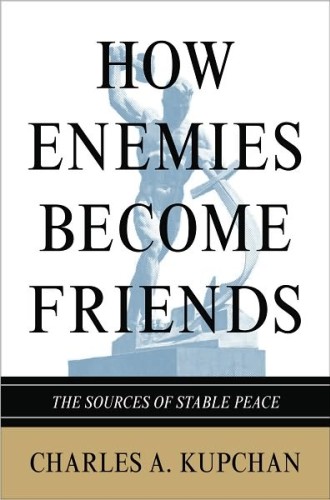A review of How Enemies Become Friends
Countries, not individuals, are the enemies and friends that Charles Kupchan has in mind in How Enemies Become Friends, and beginning with the book's title, he sets himself against the most influential school of thought in international relations.
Nations as friends? The redoubtable British foreign secretary Viscount Palmerston announced to the House of Commons in 1848: "As to the romantic notion that nations or Governments are much or permanently influenced by friendships, . . . I say that those who maintain those romantic notions, and apply the intercourse of individuals to the intercourse of nations, are indulging in a vain dream." Palmerston's statement belongs squarely in the tradition of political realism, exemplified by thinkers from St. Augustine to Reinhold Niebuhr. For realists, politics is always tragic. Countries cannot be loyal to one another like personal friends can be. Sound statecraft requires flexibility and hence, at times, betrayal.
Read our latest issue or browse back issues.
Kupchan, a prominent academic and policy analyst who has published major works on the vulnerability of empire and the future of American power, considers this no-friends principle self-evidently false. If friendship is understood as trust so deep that armed hostility is inconceivable, then Palmerston's own Britain has been friends with onetime adversary the United States for more than a century and indeed is a member of the most impressive international friendship success story of all, the European Union. These friendships did not come about from conquest; they were and remain voluntary.
Kupchan roams across eight centuries of history to assemble a dozen cases in which enemies freely became friends. Stable peace among nations takes various forms. Some states, such as Brazil and Argentina since the 1980s, are content to remain completely separate; others—the great powers of Europe from 1815 to 1848—go further and form a sort of community; yet others—the tribes of the Iroquois Federation from 1450 to 1777—go still further and build a union with a common identity.
In this learned, lucid, fascinating account, Kupchan describes both what causes enemies to become friends and the process by which they do it. The stories he tells of Japanese diplomats, American colonists, Gulf Arab emirs and Italian patriots are at once sobering and hopeful: they recognize conflicts of interest, the difficulties of building trust and the burial of old enmities.
Ironically, the process by which states become friends is triggered by a situation familiar to realists. Two or more states find themselves facing a common threat, either foreign or domestic, and begin to signal to one another a new willingness to accommodate. Over time, mutual accommodation becomes self-reinforcing, as governments and the societies they govern come to trust one another and believe the best of one another's motives. War becomes unthinkable and something very like friendship takes hold. In the late 13th century, three cantons of the Holy Roman Empire found that their Hapsburg emperor was tightening control over them and raising their taxes steeply. The three formed a pact under which they would not only jointly defy the Hapsburgs but also institute binding dispute-resolution mechanisms among themselves. Over the centuries this confederation broadened and deepened into modern Switzerland.
To be sure, these stable relationships can backslide. The Swiss cantons fell into a number of civil wars—the most destructive in 1531, when urban Protestant (Zwinglian) and rural Catholic cantons fought. One of the many virtues of Kupchan's book is that he documents failures and offers an explanation for those as well. The Iroquois Federation dissolved into warfare in 1777; rapprochement between Britain and Japan collapsed in the early 1920s, and the two were at war by 1941; a confederation between Senegal and Gambia (Senegambia) fell apart in 1989, after only seven years. Stable peace can erode and end, Kupchan argues, when states lack a common culture or common social structures, or when they fail to build rules for dispute resolution.
Kupchan's conclusions will surprise many and offend some—and not only realists. Among experts who do believe that countries can become friends, the consensus has been that the two chief causes of friendship are economic interdependence (countries that trade extensively find war too expensive) and liberal democracy (democracy provides normative and institutional constraints against initiating war). Thus since the 1980s the U.S. strategy for cultivating better long-term relations with China has emphasized economic ties and promotion of democracy. Kupchan contends that these emphases are misguided. History shows that interdependence is a consequence rather than a cause of stable peace. It also shows that plenty of nondemocratic states—native American tribes, 19th-century European monarchies, Southeast Asian authoritarian states in the 1960s—have launched friendships.
Kupchan counsels policy makers to focus instead on common cultures and social structures. Norway and Sweden formed a permanent friendship in 1905, aided by cultural similarity in the form of linguistic and religious (Lutheran) ties. Britain and Japan tried the same thing at the same time, but their societies never gelled because of stark cultural differences. As for social structure, the United States' own history illustrates the problem. The Union began to fray in the 19th century as the North industrialized and its farming became completely free-soil, while slavery became more entrenched in the South. By the 1850s each side feared that the other's institutions would become nationally predominant. The Civil War and the abolition of slavery afterward are what ensured a uniform social structure in the U.S.
If Kupchan is right about culture and social structure, this is not necessarily good news. China and the U.S. are far from similar on either measure. The same is true of Israel and its Muslim neighbors. Kupchan insists that he is not forecasting a clash of civilizations, but he does advise that China look to East Asia for community, Turkey to the Muslim world. But it is not clear that culture is a good predictor of international friendship or enmity. The U.S. and Japan have formed a lasting friendship since the 1950s even though Britain and Japan failed to do so in the 1920s. As Kupchan acknowledges, culture and social structure can change. There was a time when Germans believed that their culture was fundamentally different from that of Anglo-America—poetic and communal rather than rationalistic and individualistic—and that that difference made friendship impossible.
Then too, some readers will question Kupchan's apparent assumption that international peace is the highest good. States at peace with their neighbors sometimes behave reprehensibly at home. Close cooperation among the absolute monarchies of Eastern Europe in the 19th century and within the Gulf Cooperation Council (a community of Arab states) more recently were partly a product of common interest in suppressing dissent at home. Some readers may conclude that stable international friendship sometimes exacts too high a moral price.
Others—the realists—will likely question whether countries that become friends really escape the tragedy of international politics. Niebuhr and company might note that in Kupchan's own telling, when states form a common identity they define themselves by what—or who—they are not. The Soviet Union and China in the 1950s bonded over anti-Americanism, the young American states over Anglophobia, the Gulf Cooperation Council states over fear of revolutionary Iran. If deeper inclusion of some requires deeper rejection of others, the flip side of international friendship may be international enmity.
These unintended consequences of friendship are what Palmerston had in mind in 1848. Accused of violating Britain's friendships with France, Poland and other states, Palmerston replied that he was simply avoiding a needless and destructive war with Russia. "We have no eternal allies, and we have no perpetual enemies," he told Parliament, precisely because the two—friendship with some, enmity with others—feed on each other. It is not clear that the old Victorian realist would take a different view today.






